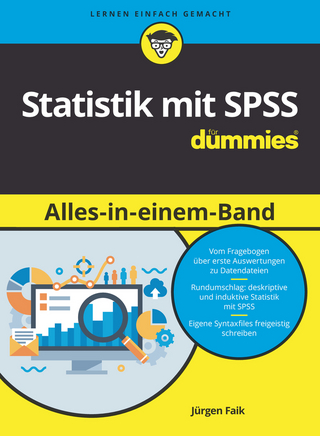
Introductory Statistics Using SPSS
SAGE Publications Inc (Verlag)
978-1-5063-4100-2 (ISBN)
The updated Second Edition of Herschel Knapp’s friendly and practical introduction to statistics shows students how to properly select, process, and interpret statistics without heavy emphasis on theory, formula derivations, or abstract mathematical concepts. Each chapter is structured to answer questions that students most want answered: What statistical test should I use for this situation? How do I set up the data? How do I run the test? How do I interpret and document the results? Online tutorial videos, examples, screenshots, and intuitive illustrations help students "get the story" from their data as they learn by doing, completing practice exercises at the end of each chapter using prepared downloadable data sets.
Herschel Knapp, PhD, MSSW, has more than 30 years of experience as a health care professional in a variety of domains. In addition to his clinical work as a psychotherapist, primarily in hospital settings, he has provided project management for innovative interventions designed to improve the quality of patient care via multisite, health science implementations. He teaches master’s and doctoral courses at Yeshiva University; he has also taught at the University of California, Los Angeles, University of Southern California, California State University, Los Angeles, and California State, San Bernardino. Dr. Knapp has served as the lead statistician on a longitudinal cancer research project and managed the program evaluation metrics for a multisite, nonprofit children’s center. His clinical work includes emergency/trauma therapy in hospital settings. Dr. Knapp has developed and implemented innovative telehealth systems, using videoconferencing technology to facilitate optimal health care service delivery to remote patients and to coordinate specialty consultations among health care providers, including interventions to diagnose and treat people with HIV and hepatitis, with special outreach to the homeless. He created and implemented a nurse research mentorship program, providing research and analytic education, enabling nurses to design, implement, analyze, and publish the results of their quality improvement projects. Dr. Knapp has published numerous articles in peer-reviewed health science journals and serves as a peer-reviewer for more than 20 science journals. He is also the author of other textbooks, including Intermediate Statistics Using SPSS (2018), Introductory Statistics Using SPSS (2nd ed., 2017), Practical Statistics for Nursing Using SPSS (2017), Therapeutic Communication: Developing Professional Skills (2nd ed., 2014), and Introduction to Social Work Practice: A Practical Workbook (2010).
Preface
Acknowledgments
About the Author
PART I: STATISTICAL PRINCIPLES
1. Research Principles
Learning Objectives
Overview—Research Principles
Rationale for Statistics
Research Questions
Treatment and Control Groups
Rationale for Random Assignment
Hypothesis Formulation
Reading Statistical Outcomes
Accept or Reject Hypotheses
Variable Types and Levels of Measure
Continuous
Interval
Ratio
Categorical
Nominal
Ordinal
Good Common Sense
Key Concepts
Practice Exercises
2. Sampling
Learning Objectives
Overview—Sampling
Rationale for Sampling
Time
Cost
Feasibility
Extrapolation
Sampling Terminology
Population
Sample Frame
Sample
Representative Sample
Probability Sampling
Simple Random Sampling
Stratified Sampling
Proportionate and Disproportionate Sampling
Systematic Sampling
Area Sampling
Nonprobability Sampling
Convenience Sampling
Purposive Sampling
Quota Sampling
Snowball Sampling
Sampling Bias
Optimal Sample Size
Good Common Sense
Key Concepts
Practice Exercises
3. Working in SPSS
Learning Objectives
Video
Overview—SPSS
Two Views: Variable View and Data View
Variable View
Name
Type
Width
Decimals
Label
Values
Missing
Columns
Align
Measure
Role
Data View
Value Labels Icon
Codebook
Saving Data Files
Good Common Sense
Key Concepts
Practice Exercises
PART II: STATISTICAL PROCESSES
4. Descriptive Statistics
Learning Objectives
Videos
Overview—Descriptive Statistics
Descriptive Statistics
Number (n)
Mean (µ)
Median
Mode
Standard Deviation (SD)
Variance
Minimum
Maximum
Range
SPSS—Loading an SPSS Data File
Run SPSS
Data Set
Test Run
SPSS—Descriptive Statistics: Continuous Variables (age)
Statistics Tables
Histogram With Normal Curve
Skewed Distribution
SPSS—Descriptive Statistics: Categorical Variables (gender)
Statistics Tables
Bar Chart
SPSS—Descriptive Statistics: Continuous Variable (age) Select by Categorical Variable (gender)—Female or Male Only
SPSS—(Re)Selecting All Variables
Good Common Sense
Key Concepts
Practice Exercises
5. t Test and Mann-Whitney U Test
Learning Objectives
Videos
Overview—t Test
Example
Research Question
Groups
Procedure
Hypotheses
Data Set
Pretest Checklist
Pretest Checklist Criterion 1—Normality
Pretest Checklist Criterion 2—n Quota
Pretest Checklist Criterion 3—Homogeneity of Variance
Test Run
Results
Pretest Checklist Criterion 2—n Quota
Pretest Checklist Criterion 3—Homogeneity of Variance
p Value
Hypothesis Resolution
a Level
Documenting Results
Type I and Type II Errors
Type I Error
Type II Error
Overview—Mann-Whitney U Test
Test Run
Results
Good Common Sense
Key Concepts
Practice Exercises
6. ANOVA and Kruskal-Wallis Test
Learning Objectives
Videos
Layered Learning
Overview—ANOVA
Example
Research Question
Groups
Procedure
Hypotheses
Data Set
Pretest Checklist
Pretest Checklist Criterion 1—Normality
Pretest Checklist Criterion 2—n Quota
Pretest Checklist Criterion 3—Homogeneity of Variance
Test Run
Results
Pretest Checklist Criterion 2—n Quota
Pretest Checklist Criterion 3—Homogeneity of Variance
Comparison 1—Text : Text With Illustrations
Comparison 2—Text : Video
Comparison 3—Text With Illustrations : Video
Hypothesis Resolution
Documenting Results
Overview—Kruskal-Wallis Test
Test Run
Results
Good Common Sense
Key Concepts
Practice Exercises
7. Paired t Test and Wilcoxon Test
Learning Objectives
Videos
Overview—Paired t Test
Pretest/Posttest Design
Step 1: Pretest
Step 2: Treatment
Step 3: Posttest
Example
Research Question
Groups
Procedure
Step 1: Pretest
Step 2: Treatment
Step 3: Posttest
Hypotheses
Data Set
Pretest Checklist
Pretest Checklist Criterion 1—Normality of Difference
Test Run
Results
Hypothesis Resolution
Documenting Results
?% Formula
Overview—Wilcoxon Test
Test Run
Results
Good Common Sense
Key Concepts
Practice Exercises
8. Correlation and Regression—Pearson and Spearman
Learning Objectives
Videos
Overview—Pearson Correlation
Example 1—Pearson Regression
Research Question
Groups
Procedure
Hypotheses
Data Set
Pretest Checklist
Pretest Checklist Criterion 1—Normality
Test Run
Correlation
Regression (Scatterplot With Regression Line)
Results
Scatterplot Points
Scatterplot Regression Line
Pretest Checklist Criterion 2—Linearity
Pretest Checklist Criterion 3—Homoscedasticity
Correlation
Hypothesis Resolution
Documenting Results
Negative Correlation
No Correlation
Overview—Spearman Correlation
Example 2—Spearman Correlation
Research Question
Groups
Procedure
Hypotheses
Data Set
Pretest Checklist
Test Run
Results
Hypothesis Resolution
Documenting Results
Alternative Use for Spearman Correlation
Correlation Versus Causation
Overview—Other Types of Statistical Regression: Multiple Regression and Logistic Regression
Multiple Regression (R2)
Logistic Regression
Good Common Sense
Key Concepts
Practice Exercises
9. Chi-Square
Learning Objectives
Video
Overview—Chi-Square
Example
Research Question
Groups
Procedure
Hypotheses
Data Set
Pretest Checklist
Pretest Checklist Criterion 1—n = 5 per Cell
Test Run
Results
Pretest Checklist Criterion 1—n = 5 per Cell
Hypothesis Resolution
Documenting Results
Good Common Sense
Key Concepts
Practice Exercises
PART III: DATA HANDLING
10. Supplemental SPSS Operations
Learning Objectives
Data Sets
Overview—Supplemental SPSS Operations
Generating Random Numbers
Sort Cases
Data Set
Select Cases
Data Set
Recoding
Data Set
Importing Data
Importing Excel Data
Data Set
Importing ASCII Data (Generic Text File)
Data Set
SPSS Syntax
Data Set
Data Sets
Good Common Sense
Key Concepts
Practice Exercises
Glossary
Index
| Erscheinungsdatum | 25.11.2016 |
|---|---|
| Verlagsort | Thousand Oaks |
| Sprache | englisch |
| Maße | 187 x 231 mm |
| Gewicht | 570 g |
| Themenwelt | Mathematik / Informatik ► Mathematik ► Computerprogramme / Computeralgebra |
| Sozialwissenschaften ► Soziologie ► Allgemeines / Lexika | |
| Sozialwissenschaften ► Soziologie ► Empirische Sozialforschung | |
| ISBN-10 | 1-5063-4100-4 / 1506341004 |
| ISBN-13 | 978-1-5063-4100-2 / 9781506341002 |
| Zustand | Neuware |
| Haben Sie eine Frage zum Produkt? |
aus dem Bereich


